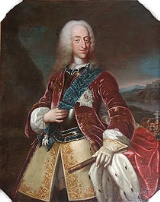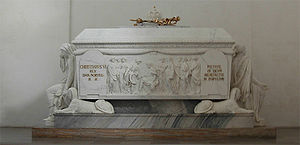
Christian VI of Denmark
Encyclopedia
Christian VI was King of Denmark
and Norway
from 1730 to 1746.
He was the son of King Frederick IV
of Denmark and Norway and Louise of Mecklenburg-Güstrow
. He married Sophia Magdalen of Brandenburg-Kulmbach
and fathered Frederick V
.
, and during his entire reign he tried to impart its teachings to his subjects. The religious pressure he imposed, along with his lack of personal charm, made him one of the most unpopular of Denmark's absolutist kings. Later historians have tried to rehabilitate his reputation. They have stressed that he was not quite so intolerant as had been said and that he was an industrious and scrupulous bureaucrat. The negative impression, however, has lasted over the years.
Christian's central domestic act was the introduction of the so-called adscription of 1733 (in Danish
, stavnsbånd
), a law that forced peasants to remain in their home regions, and by which the peasantry was subject to both the local nobility and the army. Though the idea behind this law was probably to secure a constant number of peasant soldiers, it later was widely regarded as the ultimate subjugation of the Danish peasantry. Therefore, this act, too, damaged Christian VI's reputation. The act was abolished in 1788.
The Pietist views of King Christian of course influenced much of his ecclesiastical polity. On the surface the king was victorious, but both parsons and many common people secretly resisted the king's influence. After his death, Pietism lost its official sponsorship. This did not mean that it was without effect. It influenced much of the poetry of the age, among others, that of the great hymn writer Hans Adolph Brorson
. Another lasting result of the king’s efforts was the introduction of confirmation in 1736.
In addition to pietism and adscription, there were numerous "building activities" connected to Christian VI, and he was probably the greatest Danish builder of the 18th century. His queen also made a notable effort. Among their works are Christiansborg Palace
(built 1732–42, burned 1794, rebuilt), Hirschholm Palace
in North Zealand in current day Hørsholm
municipality (built 1737–39, demolished 1812) and the Eremitage (built 1734–36, still standing). These expensive buildings were erected with the purpose of representing the power and wealth of the Danish realm, but they also became an economic burden on the subjects.
Christian's foreign policy was a peaceful one, and Denmark kept strictly neutral. In both trade and commerce, it was an age of advancement; some new companies and banks were founded.
Personally, Christian VI was a puritan of simple habits, and a man with a tendency to shun human society. From his youth, he was sickly, and several diseases led to his early death.
On his death in 1746, Christian VI was interred in Roskilde Cathedral
. The neoclassical
memorial designed and produced by sculptor Johannes Wiedewelt
was commissioned by the king's widow. The marble monument was completed in 1768, but not installed at Roskilde Cathedral until 1777. The monument includes a sarcophagus and two female figures, "Sorgen" ("Sorrow") and "Berømmelsen" ("Fame"). This was the first neoclassical sarcophagus in Denmark and is considered to mark the start of neoclassicism in Denmark.

|-
Denmark
Denmark is a Scandinavian country in Northern Europe. The countries of Denmark and Greenland, as well as the Faroe Islands, constitute the Kingdom of Denmark . It is the southernmost of the Nordic countries, southwest of Sweden and south of Norway, and bordered to the south by Germany. Denmark...
and Norway
Norway
Norway , officially the Kingdom of Norway, is a Nordic unitary constitutional monarchy whose territory comprises the western portion of the Scandinavian Peninsula, Jan Mayen, and the Arctic archipelago of Svalbard and Bouvet Island. Norway has a total area of and a population of about 4.9 million...
from 1730 to 1746.
He was the son of King Frederick IV
Frederick IV of Denmark
Frederick IV was the king of Denmark and Norway from 1699 until his death. Frederick was the son of King Christian V of Denmark and Norway and Charlotte Amalie of Hesse-Kassel .-Foreign affairs:...
of Denmark and Norway and Louise of Mecklenburg-Güstrow
Louise of Mecklenburg-Güstrow
Louise of Mecklenburg-Güstrow was Queen consort of Denmark and Norway as the first spouse of the King Frederick IV of Denmark....
. He married Sophia Magdalen of Brandenburg-Kulmbach
Sophia Magdalen of Brandenburg-Kulmbach
Sophia Magdalene of Brandenburg-Kulmbach was queen-consort of Denmark and Norway as the wife of King Christian VI of Denmark and Norway.-Background:...
and fathered Frederick V
Frederick V of Denmark
Frederick V was king of Denmark and Norway from 1746, son of Christian VI of Denmark and Sophia Magdalen of Brandenburg-Kulmbach.-Early life:...
.
The reign and personality of Christian VI
To posterity Christian VI is known foremost as a religious ruler. He was deeply devoted to PietismPietism
Pietism was a movement within Lutheranism, lasting from the late 17th century to the mid-18th century and later. It proved to be very influential throughout Protestantism and Anabaptism, inspiring not only Anglican priest John Wesley to begin the Methodist movement, but also Alexander Mack to...
, and during his entire reign he tried to impart its teachings to his subjects. The religious pressure he imposed, along with his lack of personal charm, made him one of the most unpopular of Denmark's absolutist kings. Later historians have tried to rehabilitate his reputation. They have stressed that he was not quite so intolerant as had been said and that he was an industrious and scrupulous bureaucrat. The negative impression, however, has lasted over the years.
Christian's central domestic act was the introduction of the so-called adscription of 1733 (in Danish
Danish language
Danish is a North Germanic language spoken by around six million people, principally in the country of Denmark. It is also spoken by 50,000 Germans of Danish ethnicity in the northern parts of Schleswig-Holstein, Germany, where it holds the status of minority language...
, stavnsbånd
Stavnsbånd
The Stavnsbånd was a serfdom-like institution introduced in Denmark in 1733 in accordance with the wishes of estate owners and the military. It bonded men between the ages of 18 and 36 to live on the estate where they were born. It was possible, however, to purchase a pass releasing one from this...
), a law that forced peasants to remain in their home regions, and by which the peasantry was subject to both the local nobility and the army. Though the idea behind this law was probably to secure a constant number of peasant soldiers, it later was widely regarded as the ultimate subjugation of the Danish peasantry. Therefore, this act, too, damaged Christian VI's reputation. The act was abolished in 1788.
The Pietist views of King Christian of course influenced much of his ecclesiastical polity. On the surface the king was victorious, but both parsons and many common people secretly resisted the king's influence. After his death, Pietism lost its official sponsorship. This did not mean that it was without effect. It influenced much of the poetry of the age, among others, that of the great hymn writer Hans Adolph Brorson
Hans Adolph Brorson
Hans Adolph Brorson was a Danish Pietist bishop and hymn writer.Brorson belonged to a clerical family, both of this brothers were energetic and successful Pietist vicars. He began publishing hymns in 1732 while a pastor in southern Jutland...
. Another lasting result of the king’s efforts was the introduction of confirmation in 1736.
In addition to pietism and adscription, there were numerous "building activities" connected to Christian VI, and he was probably the greatest Danish builder of the 18th century. His queen also made a notable effort. Among their works are Christiansborg Palace
Christiansborg Palace
Christiansborg Palace, , on the islet of Slotsholmen in central Copenhagen, is the seat of the Folketing , the Danish Prime Minister's Office and the Danish Supreme Court...
(built 1732–42, burned 1794, rebuilt), Hirschholm Palace
Hirschholm Palace
Hirschholm Palace, also known as Hørsholm Palace, was a royal palace located in present-day Hørsholm municipality just north of Copenhagen, Denmark...
in North Zealand in current day Hørsholm
Hørsholm
Hørsholm Kommune is a municipality in the Copenhagen Capital Region in the northern part of the island of Zealand in eastern Denmark. The municipality covers an area of 31 km², and has a total population of 24,197...
municipality (built 1737–39, demolished 1812) and the Eremitage (built 1734–36, still standing). These expensive buildings were erected with the purpose of representing the power and wealth of the Danish realm, but they also became an economic burden on the subjects.
Christian's foreign policy was a peaceful one, and Denmark kept strictly neutral. In both trade and commerce, it was an age of advancement; some new companies and banks were founded.
Personally, Christian VI was a puritan of simple habits, and a man with a tendency to shun human society. From his youth, he was sickly, and several diseases led to his early death.
On his death in 1746, Christian VI was interred in Roskilde Cathedral
Roskilde Cathedral
Roskilde Cathedral , in the city of Roskilde on the island of Zealand in eastern Denmark, is a cathedral of the Lutheran Church of Denmark. The first Gothic cathedral to be built of brick, it encouraged the spread of the Brick Gothic style throughout Northern Europe...
. The neoclassical
Neoclassicism
Neoclassicism is the name given to Western movements in the decorative and visual arts, literature, theatre, music, and architecture that draw inspiration from the "classical" art and culture of Ancient Greece or Ancient Rome...
memorial designed and produced by sculptor Johannes Wiedewelt
Johannes Wiedewelt
Johannes Wiedewelt , Danish neoclassical sculptor, was born in Copenhagen to royal sculptor to the Danish Court, Just Wiedewelt, and his wife Birgitte Lauridsdatter...
was commissioned by the king's widow. The marble monument was completed in 1768, but not installed at Roskilde Cathedral until 1777. The monument includes a sarcophagus and two female figures, "Sorgen" ("Sorrow") and "Berømmelsen" ("Fame"). This was the first neoclassical sarcophagus in Denmark and is considered to mark the start of neoclassicism in Denmark.

Ancestry
|-

